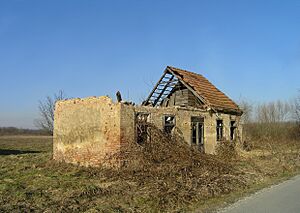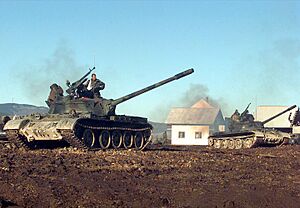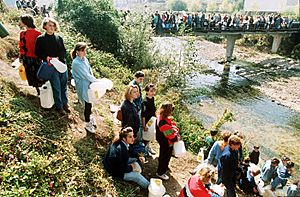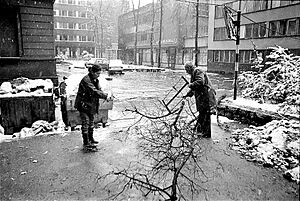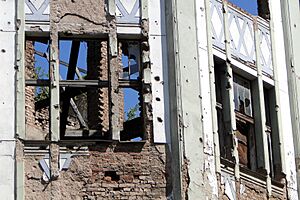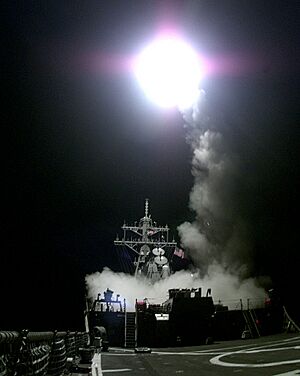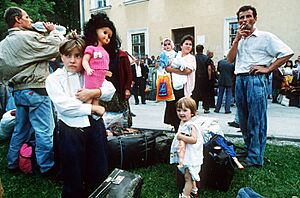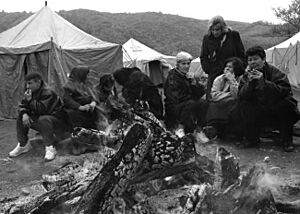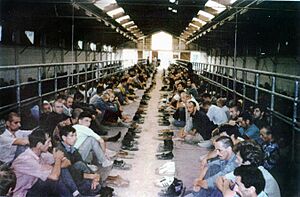Yugoslav Wars facts for kids
The Yugoslav Wars were a series of conflicts that happened in the country of Yugoslavia between 1991 and 2001. These wars marked the breakup of Yugoslavia into several independent countries. They were very complicated, involving different groups of people and their leaders.
Contents
What Was Yugoslavia?
Before the wars, Yugoslavia was a large country in Southeastern Europe. It was made up of six republics: Slovenia, Croatia, Bosnia and Herzegovina, Serbia, Montenegro, and North Macedonia. There were also two autonomous provinces within Serbia: Vojvodina and Kosovo. Many different ethnic groups lived there, including Serbs, Croats, Bosniaks, Slovenes, Macedonians, and Montenegrins. They had different religions and cultures.
A Country United and Divided
Yugoslavia was created after World War I. It was later led by a strong leader named Josip Broz Tito for many years. Tito kept the different groups together. However, after he died in 1980, tensions between the ethnic groups grew. Each republic started wanting more independence.
Why Did the Wars Start?
The main reason for the wars was the rise of nationalism. This is a strong feeling of pride in one's own nation or ethnic group. Some leaders encouraged these feelings. Different groups wanted their own independent countries. They also wanted to control certain areas where their people lived.
Breaking Apart
In 1991, Slovenia and Croatia were the first to declare independence from Yugoslavia. This led to fighting. Other republics soon followed, and the conflicts spread.
Main Conflicts of the Wars
The Yugoslav Wars were not just one war. They were several separate conflicts.
War in Slovenia (1991)
Slovenia was the first to declare independence. The fighting there was short, lasting only ten days. It is sometimes called the "Ten-Day War." Slovenia gained its independence quickly.
War in Croatia (1991-1995)
When Croatia declared independence, many Serbs living in Croatia did not agree. They wanted to stay part of Yugoslavia or join Serbia. This led to a long and brutal war. Cities were damaged, and many people had to leave their homes.
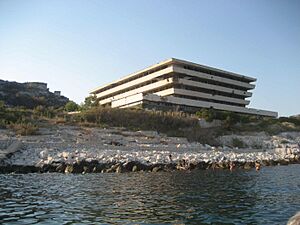
War in Bosnia and Herzegovina (1992-1995)
This was the most devastating part of the wars. Bosnia and Herzegovina was very diverse, with Bosniaks (mostly Muslim), Serbs (mostly Orthodox Christian), and Croats (mostly Catholic) living there. When Bosnia declared independence, all three groups fought for control.
Siege of Sarajevo
The capital city, Sarajevo, was surrounded and attacked for almost four years. This was the longest siege of a capital city in modern history. People in Sarajevo suffered greatly, with little food, water, or electricity.
Kosovo War (1998-1999)
The last major conflict was in Kosovo, a province in Serbia. Most people in Kosovo were ethnic Albanians. They wanted independence from Serbia. The fighting led to a NATO bombing campaign against Serbia in 1999.

Life During the Wars
The wars caused immense suffering. Millions of people became refugees, meaning they had to flee their homes to find safety. Many civilians were killed or injured. Cities and towns were destroyed.
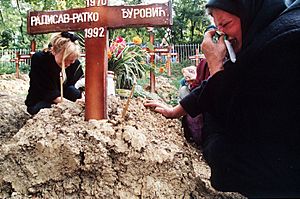
What Happened Next?
The wars ended with peace agreements. Yugoslavia broke apart completely. New independent countries were formed: Slovenia, Croatia, Bosnia and Herzegovina, North Macedonia, Serbia, and Montenegro. Kosovo later declared its independence in 2008, though not all countries recognize it. The region is still recovering from the wars, but it is now much more peaceful.
Images for kids
-
Photo of ambushed JNA tanks near Nova Gorica, on the border with Italy
See also
 In Spanish: Guerras yugoslavas para niños
In Spanish: Guerras yugoslavas para niños


